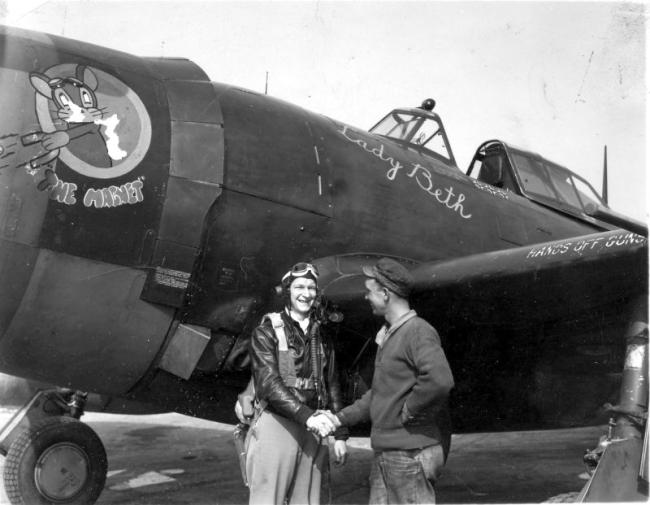Boxted
Airfield
IWM, English Heritage Collection
Object Number - RAF_58_215_V_5086 - Aerial photograph of Boxted airfield, looking south west, the ammunition dump and bomb dump are at the bottom of the image, 18 April 1949. Photograph...
Boxted was built for heavy bombers and became operational from May 1943. In the few months B-26 Marauders of the 386th Bomb Group were stationed there, there were two night attacks by the Luftwaffe. On 17 August 1943, one man was killed when bombs fell amongst the Nissen huts.
The next unit to fly from Boxted was the 354th Fighter Group, a Ninth Air Force group temporarily under control of VIIIth Fighter Command. They flew escorts for long-range bombing missions, including the first P-51 Mustang mission in the ETO. In preparation for the invasion of Normandy, the 354th moved to Lashenden in Kent, and the 56th Fighter Group took their place. This unit was one of the most famous in the Eighth Air Force, on account of its high numbers of 'ace' pilots. For a large part of 1944 the base also hosted an air-sea rescue unit at its northern edge, a nearby farmhouse being used as the its administrative building.
Roger Freeman, author of 'The Mighty Eighth' series of books about the USAAF, lived nearby and frequented the base during the war. His father, a farmer, had permission to cut grass at the airfield to make hay.
Connections
See how this entry relates to other items in the archive by exploring the connections below.
English Heritage's Record Description
The site of a former military airfield opened in 1943 and closed in 1947. The airfield was mainly used by units of the United States Army 8th Air Force, principally 386th Bomber Group, and 56th Fighter Group, and also by 354th Fighter Group of the 9th Air Force and 65th Air Sea Rescue. Dispersed barrack sites were located to the south of the flying field. After American forces left the base in September 1945 the Royal Air Force flew Mosquitos and then Meteor (early jet) aircraft from the base. The establishment of the base was run down and Boxted closed as an active military airfield in 1947. The airfield was used for crop spraying into the 1960s but the site returned to agricultural use and is now covered by orchards
People

- Military/Civilian/Mascot: Military
- Nationality: American
- Unit: 56th Fighter Group 63rd Fighter Squadron
- Service Numbers: 17115540 / O-702766
- Highest Rank: First Lieutenant
- Role/Job: Fighter pilot
- Military/Civilian/Mascot: Military
- Nationality: American
- Unit: 495th Fighter Training Group 56th Fighter Group 63rd Fighter Squadron
- Service Numbers: 38031311 / O-661268
- Highest Rank: Captain
- Role/Job: Fighter pilot
- Military/Civilian/Mascot: Military
- Nationality: American
- Unit: 56th Fighter Group 63rd Fighter Squadron
- Service Numbers: O-715993
- Highest Rank: First Lieutenant
- Role/Job: Fighter pilot
- Military/Civilian/Mascot: Military
- Nationality: American
- Unit: 56th Fighter Group 61st Fighter Squadron
- Highest Rank: Captain
- Role/Job: Fighter pilot

- Military/Civilian/Mascot: Military
- Nationality: American
- Unit: 56th Fighter Group 62nd Fighter Squadron
- Service Numbers: 15069344
- Highest Rank: Staff Sergeant
- Role/Job: Crew Chief
Aircraft

- Aircraft Type: P-47 Thunderbolt
- Nicknames: The Magnet/ Lady Beth
- Unit: 56th Fighter Group 62nd Fighter Squadron

- Aircraft Type: P-47 Thunderbolt
- Nicknames: Little Chief - Anderson Indian
- Unit: 56th Fighter Group 61st Fighter Squadron Headquarters (56th Fighter Group)

- Aircraft Type: P-47 Thunderbolt
- Unit: 353rd Fighter Group 56th Fighter Group 351st Fighter Squadron 63rd Fighter Squadron
- Aircraft Type: P-47 Thunderbolt
- Nicknames: Six Shooter Junction
- Unit: 56th Fighter Group 61st Fighter Squadron

- Aircraft Type: P-47 Thunderbolt
- Unit: 56th Fighter Group 63rd Fighter Squadron
Revisions
Barry Anderson, Army Air Forces Stations (Alabama, 1985) / Roger Freeman, Airfields of the Eighth Then And Now (London, 1978)

![Lieutenant Robert W Stephens of the 354th Fighter Group with his P-51 Mustang. Image stamped on reverse: 'Barratt's Photo Press.' [stamp], '300571.' [Censor no] A printed caption was previously attached to the reverse, however this has been removed. Handwritten caption on reverse: 'Lt Robert W Stephens, 355FS/ 354 FG Boxted 18/1/44, 7th Ranking (AF at VE Day, 13 victories).'](https://assets.americanairmuseum.com/s3fs-public/styles/max_650x650/public/freeman/media-377121.jpg?itok=Z6KkjZXQ)
![Staff-Sergeant George Leonard (Crew Chief) and Sergeant Bob Seager (Assistant Crew Chief) of the 354th Fighter Group work on the engine of a P-51 Mustang (serial number 43-12410) flown by Charles Gumm. Boxted, January 1944. Image stamped on reverse: 'Associated Press.' [stamp] A Printed caption was previously attached to the reverse, however this has been removed.](https://assets.americanairmuseum.com/s3fs-public/styles/max_650x650/public/freeman/media-377122.jpg?itok=n5Y9Jgik)








